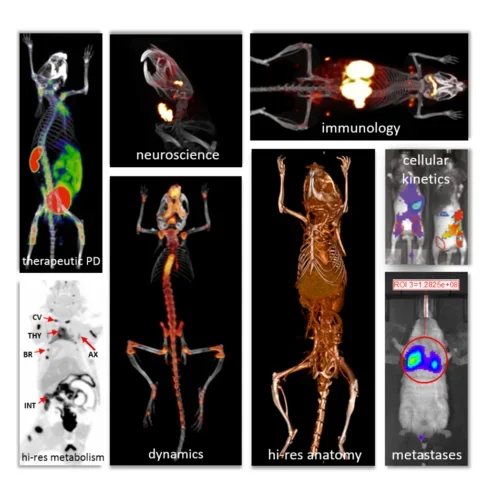Technology Centers
Preclinical Imaging & Crump Cyclotron and Radiochemistry Technology Center
Director: Shili Xu
The Crump Institute's Preclinical Imaging & Radiochemistry Technology Center provides state-of-the-art in vivo molecular imaging technologies and related services to faculty, staff and students at UCLA. The Center functions both as a laboratory facility for imaging research and development, and as a shared preclinical imaging resource for researchers across various disciplines on campus. As a world leader in molecular imaging, the Center aims to connect state-of-the-art technologies and imaging expertise with in vivo biological applications, to allow real-time, quantitative measurement of health and disease.
The Imaging Center offers a variety of molecular imaging services including:
- Positron emission tomography (microPET)
- Computed tomography (microCT)
- Bioluminescence imaging (BLI)
- Fluorescence imaging
- Radiolabeled small molecules
- Radiolabeling lab and workspace
- Tissue and whole body digital autoradiography
- Automatic gamma counter
- Cell culture hood and workspace
In vivo imaging systems include:
- One combined PET/CT scanner (Genisys8)
- Two stand-alone PET scanners (Inveon and Focus 220)
- Two stand-alone CT scanners (microCAT and in-house CrumpCAT)
- Two combined bioluminescence/fluorescence imaging systems (IVIS Lumina II)
Companion PET tracer radiochemistry and radiolabeling services and facilities are available in-house. Adjacent to the Imaging Center is a barrier facility for housing animals before and after imaging with biosafety cabinets for animal procedures. The facility is fully certified for animal, radiation, laboratory, biological (BSL2) and chemical safety procedures.

Engineering and Prototyping Technology Center
Director: Michael van Dam
To have an impact in the world, promising technologies must eventually move out of the laboratory and into other research labs and clinics. The mission of the Engineering and Prototyping Technology Center is to facilitate transitions from proof-of-concept to working prototype and potentially commercialization. Development of prototype systems enable sharing of new technology between engineers and research scientists, benefiting the science to which the technology is applied, as well as providing feedback for improvements of the technology itself.
The Engineering and Prototyping Technology Center comprises two laboratories in the new Crump Institute space in the CNSI Building: the Mechanical Prototyping Laboratory and the Micro/Nano Fabrication Laboratory. It brings together expertise and state-of-the-art facilities for mechanical design and engineering, precision machining, instrument prototyping and microfluidic device fabrication. In the future, we hope to also establish expertise and facilities for electrical engineering, electronics, control system development and user-interface development. These final stages of prototyping are critical when a system is to be used in a different laboratory.
The mechanical prototyping laboratory contains CAD/CAM workstations, a fully-equipped machine shop, and an assembly and testing area. State-of-the-art equipment includes a CNC milling machine (Haas OM-2A), CNC lathe (Haas HPCL), manual mill (Bridgeport 12BR2J), drill press, vertical band saw, horizontal band saw, and grinder. Machines and tools are available to members of the Crump lnstitute. In the future, the center hopes to provide support staff with expertise in design, drafting, manual machining, and CNC machining to assist with prototyping projects and to provide training in design and machining.
The Micro/Nano Fabrication laboratory is a class 1000 cleanroom located within the CNSI Integrated Systems Nanofabrication Cleanroom (ISNC). The lab contains equipment for microfluidic device fabrication from poly(dimethylsiloxane) (PDMS), glass, and other materials: fume hoods for solvent and acid/base processing, photoresist and PDMS spin coaters (Laurell Technologies WS-650SZ-6NPP/LITE), PDMS vacuum degasser, programmable ovens (Fisher Isotemp), CCD-assisted hole-punching tool, zoom stereomicroscopes (Nikon SMZ-1000), oxygen plasma bonding system (Harrick PDC-001), corona discharge bonding system (Enercon Industries LM4816-11MS-MSA), and a microfluidic chip test station. A biosafety cabinet provides a sterile environment for preparation of microfluidic cell cultures. Extensive additional state-of-the-art facilities for fabrication and characterization of micro- and nano-devices are available on a shared basis in the ISNC, the Nanoelectronics Research Facility (“Nanolab”), and the Nano and Pico Characterization Laboratory (NPL), including photolithography, reactive ion etching, metal deposition, stylus and optical profilometry, scanning electron microscopy, etc. The cleanroom space and equipment are available to members of the Crump Institute.
